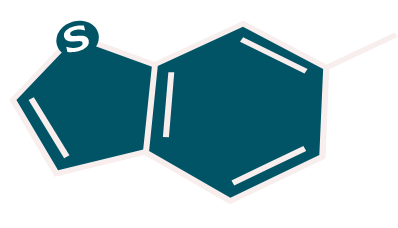Draw & Study,
「YU canvas」 (0.5 beta)
Now Loading...
This program uses JavaScript.
If loading takes more than a minute, please check if JavaScript is enabled in the browser.
Basic Information
Chemical Formula
-
Molecular Weight
-
Predicted Properties
LUMO
-
HOMO
-
Ease of Synthesis
-
Analog molecules generated by AI
Energy Diagram
Overview
"YU canvas" is a software for designing functional molecules, developed by Matsui laboratory at Yamagata University, Japan. You can draw molecules in the left-side canvas, and see the predicted properties immediately in the right-side table.
How to Draw Molecules
- 1. Select a machine learning model.
- 2. Select the predictive characteristics. (currently HOMO & LUMO only)
- 3. Choose one of the parts such as benzene ring.
- 4. Place the part in the white canvas.
- 5. Predicted values are output.
See JSME help page for details.
FAQ
- What are LUMO, HOMO, Gap, Vacuum, SHE, and Ease of Synthesis?
- LUMO stands for lowest unoccupied molecular orbital, and represents electron affinity.
HOMO stands for highest occupied molecular orbital, and represents ionization potential.
Gap is the different between LUMO and HOMO, and is related to optical absorption and emission.
Vacuum is vacuum level.
SHE is hydrogen standard electrode potential in electrochemistry.
Ease of synthesis indicates the degree of difficulty in synthesis: closer to 1, the easier it is to synthesize; closer to 10, the harder it is to synthesize.
- How does it predict the properties?
- It uses machine learning of artificial intelligence (AI). The details will be published in near future.
- What are the analog molecules generated by AI?
- Analog molecules are generated using a machine learning model called variational autoencoder (VAE) for the next prediction.
- How accurate the predicted properties are?
- The mean absolute error (MAE) with respect to density functional theory (DFT) calculation of B3LYP/6-31G(d,p) is 0.3 eV at present. Future updates would improve the accuracy.
- Why does it show "n/a" (not available)?
- This program is under development, and does not support all molecules. Future updates would extend the supported molecules.
- Can we use the predicted properties for scientific publications?
- It is NOT recommended to use the predicted properties for scientific publications because the validity of the predicted properties is not guaranteed.
Authors
Matsui Laboratory, Research Center for Organic Electronics (ROEL), Yamagata University
Hiroyuki Matsui, Tomoharu Okada, Yuki Mochizuki, Ren Sasaki, Yu Homma, Koki Ozawa
E-mail: h-matsui[at]yz.yamagata-u.ac.jp
* Please replace [at] with @.
Disclaimer
The validity of the predicted properties is not guaranteed. It is NOT recommended to use the predicted properties for scientific publications. The authors is not responsible for any results from this program.
Acknowledgements
This work was supported by JST, CREST, Grand Number JPMJCR18J2.
This program uses JSME Molecular Editor and Kekule.js.
